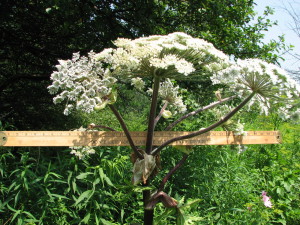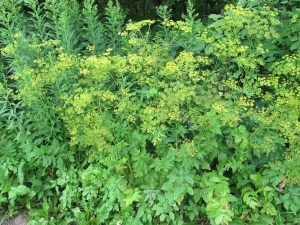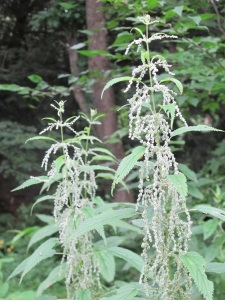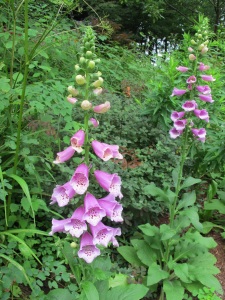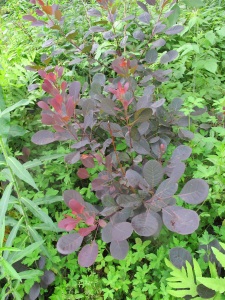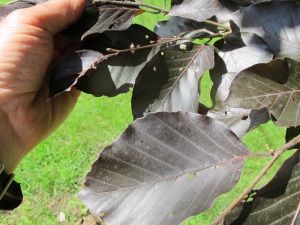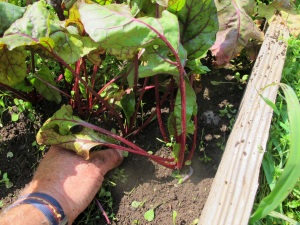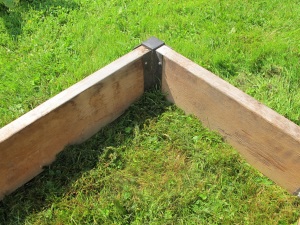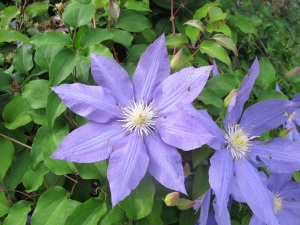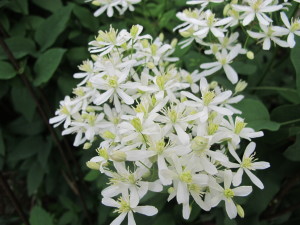Plants to Watch Out For
If you have a wet area or a stream on your property, you might be seeing some very pretty tall pinky-purple flowers blooming now, or soon. Those are purple loosestrife (Lythrum salicaria), an invasive plant that you should not encourage. Mature plants develop massive root systems and can produce up to a million seeds in a year. It’s one of several plants you should watch out for.
So what can you do? First, learn to recognize purple loosestrife when it first grows, even before blooming. It has a square stem, and it is often reddish or brownish at the base. The leaves are long and thin. Each year I try to find time to cut back the stems more than once, reducing its vigor and preventing it from blooming. I pull new plants, but the established ones can’t be weeded out.
Purple loosestrife came from Europe long ago, and there it is not a problem – it evolved along with insects that eat it and keep it from becoming a pest. One of those beetles has been approved for release in the United States and is helping to control loosestrife in some places, but the beetles are not for sale. By cutting it back, I am acting like a big beetle.
Another bad actor is giant hogweed (Heracleum mantegazzianum). It is a huge plant – often more than 6 feet tall, with huge palmate leaves (shaped a bit like maple leaves, or your hand) and numerous small white flowers arranged on umbels (umbels are like the stays of an umbrella) that can exceed 3 feet in diameter. I bought one once, before I knew it was invasive. It can grow anywhere – sun or shade, wet or dry – and has a tap root that goes down two feet or more. Worse yet, the sap is highly toxic to many people and can create severe burns and even scars – particularly if you get exposed to it in full sun.
Fortunately, I am not allergic to hogweed, and I was able to rid myself of it by digging it out with my long drain spade, a shovel with a blade that is only 6 inches wide, but 16 inches long. On the other hand, it is a fabulous looking plant and wish I could safely grow it. It is on the invasive species list in many states.
A similar plant growing by the roadside right now is wild parsnip (Pastinaca sativa). This, too, has a sap that can burn the skin of many people (but not me). It only grows four feet or so tall, and has a yellow blossom like Queen Anne’s Lace. It is related to carrots – and giant hogweed. According to Sam Thayer’s wonderful book, The Forager’s Harvest, the tall plant we are seeing now is biologically identical to the parsnips we plant in the garden. It is a biennial plant, and Thayer eats the first year wild parsnips, but explains the second year roots are not edible. He states that wild parsnips look a lot like water hemlock, which is extremely poisonous. So do not take any chances!
Stinging nettle (Urtica dioica) is another pest – but one that has its virtues. It can grow almost anywhere, but does best in rich, fertile and moist soils. It has tough little hairs that act as hypodermic needles, delivering a cocktail of chemicals that sting and can produce a rash. Cooking or drying the leaves, however, eliminates the sting and nettles have a long history as an edible plant and medicinal herb.
Nettles can be cooked and eaten like spinach early in the spring. At this time of year the stems and leaves have gotten tough and are not recommended for eating. The plant itself gets to be 5 to 8 feet tall with leaves in opposite pairs that have toothy margins. It is very nutritious – it is up to 25% protein when dried. When dried, it makes a tea that I don’t like very much. Nettles are a good source of Vitamin C and A. I generally leave stinging nettles alone, though I pull them, wearing gloves, if they get into a flowerbed or too close to a path.
Three lovely garden plants that I grow have potentially poisonous side effects: castor bean (Ricinus communis), angel’s trumpet (Datura spp.) and foxglove (Digitalis purpurea). All three have poisonous seeds and (to a lesser degree) leaves. I don’t worry about them because I can’t see anyone – even a child – eating them. Castor beans and angel’s trumpet both have spiny coverings on their seed pods, and foxglove plants have very tiny seeds.
Castor beans can be used to make ricin, a very poisonous powder that can be fatal if inhaled or ingested. In 2013 a crazy guy sent ricin in a letter to President Obama. Fortunately, like kings of old who had tasters, he doesn’t open his own mail. But the plant is big, with palmate leaves in tones of red or bronze. I find it easy to start from seed.
Angel’s trumpet is my substitute for Oriental and Asiatic lilies, which are so badly attacked by lily-leaf beetles that hand-picking daily can’t keep them looking good. Unlike the lilies, it blooms all summer! It comes in white and purple-flowered varieties; the white ones are much more vigorous.
Foxglove is an old favorite of mine. It’s a biennial that produces pink-purple blossoms on tall stems. If you let it, it will drop seeds to the soil, and, in two years will bloom again unless you have s thick layer of mulch, which will inhibit the seeds.
Knowing your plants – and any potential negatives – is important, especially if you keep animals who are likely to nibble on your plants.
Henry is the author of 5 books. His websites are www.Gardening-Guy.com and www.henryhomeyer.com.
Growing Fruit
I try not to be too compulsive, but admit that I counted every sour cherry I picked from my tree this year. Give or take a few I ate while picking, I got 111 cherries -not enough for a pie. I planted the tree some 15 years ago, and this was my best crop. Last year I threatened it with the chain saw, and it upped its production from 5 or 6 to over 100 cherries. Maybe next year it will produce a thousand. Maybe not. I’ll probably cut it down.
Fruit trees, I’ve always been told, do not like “wet feet”. By that I mean their roots should be in soil that is not consistently wet. Apples, pears, peaches, cherries, and plums grow best in rich soil with full sun and well drained but lightly moist soil. Most of my full sun is alongside a brook with a water table that is consistently high – within two feet in dry times, a foot or less in spring. So, back in the 1980’s, when I was young and full of pep, I built a terrace to grow fruit trees.
A friend had a dilapidated stone wall along his road that he had picked over, taking the nicest flat stones for a wall elsewhere on his land. But he said I could take anything I wanted, warning me that building with round stones is not easy. It wasn’t. But the price was right, and I had a little trailer, so I hauled rocks, a dozen at a time, to my back yard. I built an 80-foot retaining wall, and bought topsoil to backfill behind it. The truck couldn’t get to the site, so I moved many dump truck-loads the final distance by wheelbarrow. Ah, to be young and foolish again.
I tell you all this because I feel like I‘ve done a lot for this darn cherry tree, and I’m pretty sure I’ll cut it down this year or next. I know my e-mail inbox will be full of mail asking me to spare the tree. But my thought is this: if a tree does not live up to your expectations and you have given it a fair chance, get out the chain saw. I have limited space for fruit trees. And 111 cherries is not worth the space. The blossoms are not special, either.
The irony is that since I built the wall and planted fruit trees, I have had good luck planting them in the field near my stream. I just built up something akin to a major league pitcher’s mound, and planted where the pitcher would stand. Ten feet across, and rising up about a foot. I’ve planted plums and apples, and all have done fine. So maybe that old saying about fruit trees not liking wet feet is bogus.
Meanwhile, I mowed down my blackberry patch earlier this summer. I planted a 50-foot row about 30 years ago, and the patch has slowly gone downhill. For many years it was great, and I was only able to keep the bushes contained with a mower. But recently each year there were more fungal diseases, and less production. So I will hire someone to plow the land, and rototill the roots. Then I will cover it with black plastic for the rest of the summer to kill the weeds and roots.
Next year I will plant that patch in strawberries. I will plant some June-bearing plants, probably ‘Earliglow’, that produce their entire crop in a 3-week period. They are great for freezing, and for general gluttony. It’s great to eat strawberries three times a day for a while. But I will also plant some day-neutral berries or everbearing plants that will produce smaller numbers over a longer period.
Most strawberries depend on the length of the day to tell them when it is time to produce fruit. Day-neutral berries are not dependent on that cue. The last time I grew day-neutral berries I got a nice fall crop the first year, then some berries all summer the following years, with a bigger bump in the fall. I planted ‘Tristar’ and was pleased with it. The berries were smaller than most June berries, the size of a dime to a quarter. No fifty-cent sized berries. Commercial growers in California often plant day-neutral berries so they can sell berries all year.
This spring I was at Edgewater Farm in Plainfield, NH and was seduced by a lovely pineapple plant. It displayed lots of long, strap-like leaves similar to that of an aloe plant. And best of all, it had a pineapple growing on top! It was expensive – twenty-five dollars – but I bought it anyway. I knew, from living in Africa, that pineapples plants only produce one fruit, then die. But I also knew that it is possible to start a second plant from the first.
My pineapple lived on the deck in partial sunshine and was a very nice addition to the plants there. But, come mid-July the fruit ripened to a deep yellow and then flopped over on its stem. I tied it up. It flopped anyway. I decided it was time to eat it. It was tasty, but barely one serving after peeling and coring it. Right now the plant looks good, and I’m hoping it will develop a side-shoot. If not, the experiment will be done. Meanwhile, my avocado plant I started from a pit is doing great.
Fruit is a great investment. Plant a fruit tree, sit back and relax, harvest the fruit. That’s the ideal. In fact, my cherries cost me many dollars each, if I add in the cost of the tree, the soil, and minimum wage for my time building the wall to create the space. And you know what? The cherries aren’t even very good eating! Live and learn.
Henry Homeyer is a UNH Master Gardener and the author of 4 gardening books. His web site is www.Gardening-Guy.com.
Red-leafed Plants
When I bought my house in 1970 it had no landscaping. But I’ve lived in it ever since and have been working on the gardens all that time (except when I was off seeing the world and serving in the Peace Corps). The first tree I planted was a Japanese red maple (Acer palmatum). I grew up in Connecticut and my parents had a big one in the yard that I loved. It was, I’d estimate, 40 feet tall and wide, a great broad climbing tree with maroon-colored leaves. So around 1971 I dug up a seedling and moved it north.
That little maple is still alive, but never has gotten close to the size of my parents’ tree. It’s just 10 feet tall with a 12-foot spread. Why so small? It’s growing too far north. It survives, but is stunted by the climate. Not only that, as a nearby tree has spread and shaded it, the leaves are no longer the deep purple they once were; now they have a greenish tinge. Oh well. I later got another and put it in a sunnier location and it has leaves that are a deeper reddish color.
Like many gardeners, I like plants with deep red or purplish leaves. They provide a contrast to all the greenery in our landscape. There are some nice trees and shrubs to pick from –including one very popular one that is now on the prohibited invasive species list in most states, the Norway maple ‘Crimson King’. That one is a “sport”, or genetic mutation. All Norway maples (Acer platanoides), including the green ones, are invasive.
The original Crimson King has been cloned and sold for decades. Eventually environmentalists figured out that seedlings from them having been taking over our woods, outcompeting our native maples and other plants. The seedlings generally are green-leaved, so many gardeners think they are sugar maples. Snap off a leaf and look at the stem. If it oozes white sap, it’s a Norway maple.
Norway maples have amazing root systems that steal the moisture and nutrition from the soil for long distances, depriving other plants. So if you have a nice big maple with nearly black leaves, know that it is a thug – and consider replacing it even though no plant police will come after you.
I have a fast-growing shrub with handsome dark purple leaves that would exceed the size of my Japanese red maple if I didn’t give it a yearly “haircut”. It’s a common ninebark (Physocarpus opulifolius), a variety called ‘Diablo’. This is a shrub native to the United States though I have never seen one in the woods. Diablo was introduced in 2000 and has become very popular, mainly for its leaf color which is good from spring to fall, but also for its nice 2-inch pinkish blossoms in June.
According to me, common ninebark grows too fast. Mine can grow 3 feet in a summer, and I really don’t want it to. I prefer shrubs like fothergilla or daphne that rarely need pruning. Diablo can quickly get to 10 feet tall and wide, and its root system is substantial. Hardy to Zone 2 (minus 50 degrees), nothing is going to kill it. It prefers full sun, but will tolerate anything and survive in bad soil, acid or alkaline. Planted in a row, it could be a good hedge.
Purple smoke bush (Cottinus cogyria) is a purple-leafed plant I’ve have had since 1999. Mine often dies back to the ground after a cold winter, but the roots send up new shoots no matter what. I often cut back all shoots in early spring, which stimulates it to produce new shoots and keep it a tidy shrub instead of a gangly winter-bitten one. These often grow 3 to 4 feet in a season. Doing this means it never blooms, but the foliage is a splendid deep wine color, so I don’t mind. In warmer climes it can grow to be a small tree or large shrub with large diaphanous blossoms – the smoke – that is quite glorious.
I also have a crabapple tree with dark maroon leaves. I called E.C. Brown Nursery in Thetford, VT where I bought it some 15 years ago to see if they could help me identify the cultivar. After some discussion and a look on the web, I decided it was ‘Ruby Tears.’ Mine was trained into a spiral, and has branches that weep or droop down. I’ve kept it small – it is only 8 feet tall and wide. But it has nice dark leaves that are quite striking in the spring, getting a bit greener as the season goes on. It is loaded with pink blossoms every year.
Other dark-leafed crabapples include ‘Prairie Fire’, which I have seen as a full-sized tree, or if grown on dwarfing rootstock, as a small one. All apples are grafted onto rootstocks because the seeds do not breed true. The rootstock determines the ultimate size from dwarf to full-sized. Prairie Fire has greenish-red leaves by mid-summer, getting greener as time goes on.
European beech (Fagus sylvatica) has some very nice purple-to-black-leafed cultivars, and although there is one growing in my town, I have never tried growing it. The leaves are really quite black at this time of year, and the one I have observed is 20 years old or more, about 18 feet tall and 12 feet wide. It is rated as a marginally hardy in Zone 4, but this one has survived winters approaching 30 below zero.
Planting a tree is an investment in money, time and space. Research your choices well, plant them where they will do well, and your grandchildren will enjoy them in the future.
Henry can be reached at his web site, www.Gardening-Guy.com. He is the author of 5 books and is a UNH Master Gardener.
Vegetable Gardening
Certainly the weather is, year after year, a source of much consternation for gardeners. It’s too dry! (May). It’s too wet! (June). It’s too hot! Too cold! People seem to be delighted to complain about the weather. Me? I’m generally pleased by it all. What curve ball will Mother Nature throw at us next?
Despite the yearly weather variations, some things in the garden never change. We must thin our root crops, pull weeds, mulch. We need to pick off potato bugs on our plants, and remove their orange egg masses on the underneath sides of the leaves. We need to pick slugs and snails on the cool, moist days.
One of the most tedious jobs in the vegetable garden is thinning. Baby beets crowd each other, no matter how carefully we planted them. Carrots compete with their brothers and sisters for light, water and soil nutrients. It’s time to get down on your knees and get to work, thinning.
I was recently talking to a gardener who starts her beets indoors in flats in March or April, and then divides them up and plants them individually, properly spaced. Hmm. That would certainly eliminate the thinning problem. I’ll have to try that next year.
Carrots seeds are tiny, so spacing them well at planting time is difficult and time consuming. By now, carrots should be an inch apart. Later, by the end of July, carrots need more space – but the thinnings can be eaten, a reward I relish.
Some years ago I saw prize-winning carrots that were 18 inches long on display at the Tunbridge World’s Fair in Tunbridge, VT. I was flabbergasted. I made note of the grower’s name and tracked him down. He is Joey Klein, an organic gardener in Plainfield, VT with a farm on the Winooski River. He gave me good tips on how to grow long carrots, and they worked. You can start a new bed of carrots now for fall eating and storage.
Joey grows carrots in wide raised beds, each bed about 36 inches wide and mounded up about 6 inches above the walkways. He adds lots of organic matter to the soil, especially good, mature compost. He likes to say that he harvests sunshine. His carrots and broccoli turn sunshine into food. The soil he started with was good alluvial soil that has good drainage and texture – and few rocks, a bonus for anyone who wants long, straight carrots.
If you want long luscious carrots, buy a variety that is destined to be long. Joey uses “Sugarsnax 54” from Johnny’s Selected Seeds. I use seed from Renee’s Garden Seeds, a package of mixed orange and yellow carrots called “Sunshine Orange and Yellow” that gives me huge, long carrots, especially the yellows. Mine are not as long as Joey Klein’s, but are routinely 12 inches long.
I find growing long carrots in a wood-sided raised bed with 8-inch sides allows me to create a custom soil just right for carrots. I use a 50-50 mix of topsoil and compost, mixing my garden soil with compost I buy from a local guy who buys cow barn waste and turns it into light, fluffy compost. A box 40 inches wide will grow 3 rows of carrots separated by 15 inches and with 5 inches of space from the walls.
If you are not handy with tools, Gardeners Supply Co (www.gardeners.com or 888-833-1412) sells metal corners that will help you to assemble a nice bed in just a few minutes. Their raised bed corners are sturdy and square, and all you have to do is slide in the 2-by-8’s and screw the lumber in place (a screwgun helps make that job easy).
You can set the box you build right on your lawn, fill it up and plant! The lawn will die where you place your bed, and by the second year carrots will grow right down into the soil beneath the bed (the first year, they may grow down to the lawn, then turn sideways). Raised beds are great for rainy summers, as they drain well.
To get those big carrots, keep the soil well watered in dry times. Sprinkle some organic fertilizer in the row when you plant, and again 6 weeks later. That second application should be alongside the carrots; scratch it into the soil with a hand tool. Keep out weeds, and thin the seedlings as mentioned above.
Elsewhere in the garden I have removed the row covers from my cukes, zucchini and winter squash. I cover them to keep off the striped cucumber beetles off the young plants, but now the plants are big enough to survive some munching by beetles. When the blossom appear they need pollination by insects in order to produce fruit.
By the way, vine crops like zucchini produce flowers that are either male or female, and the boys appear first. So don’t despair if you don’t get any zukes at first. The ladies will be on their way soon.
We need to visit our vegetable gardens every day – and do a few acts of service for our plants. If we keep up with it all, we are deemed good gardeners and will, most likely, be rewarded with a bountiful harvest.
Henry can be reached at P.O. Box 364, Cornish Flat, NH 03746. Please include a self-addressed stamped envelope if you want a reply. Or e-mail him at henry.homeyer@comcast.net.



